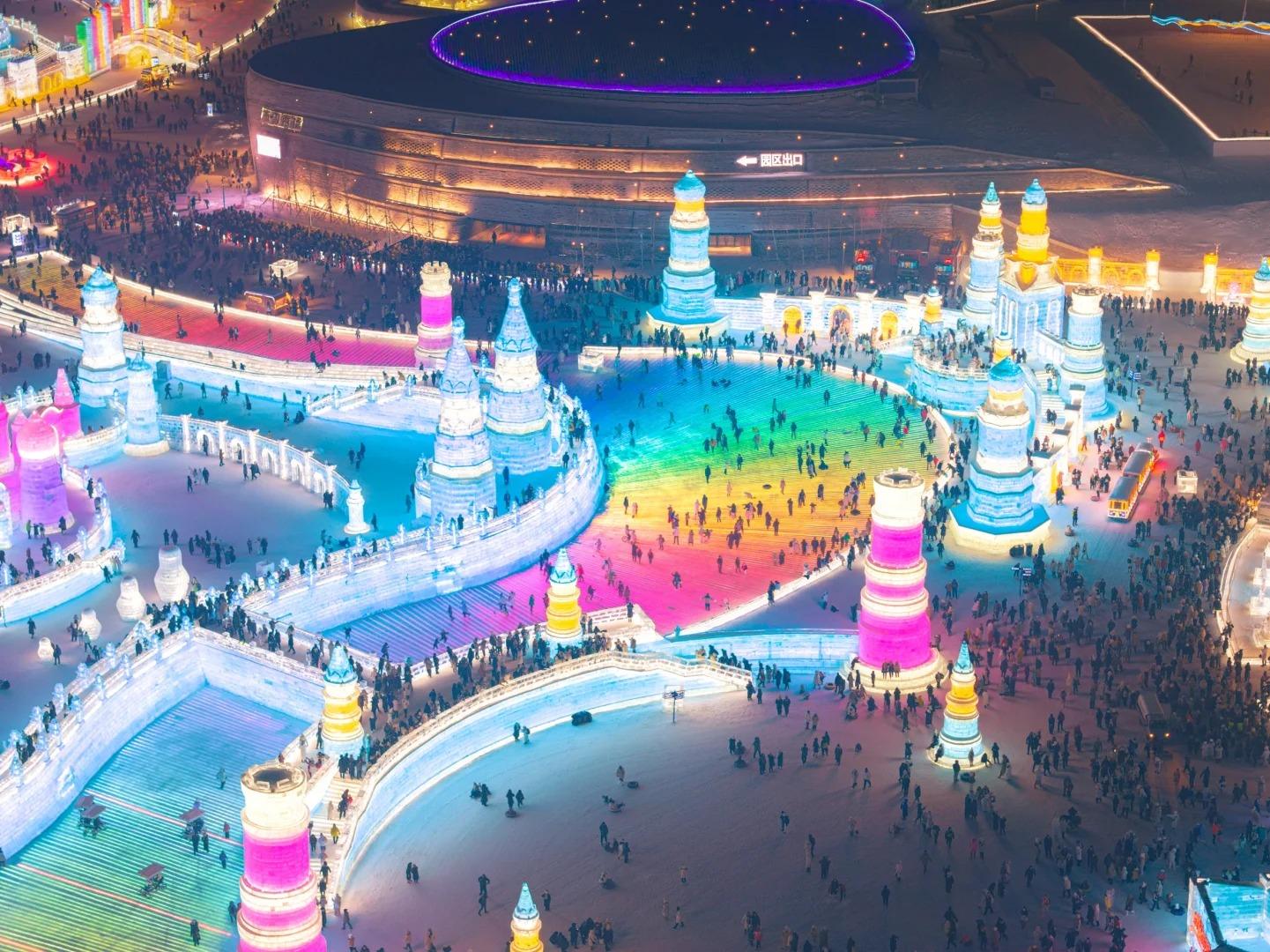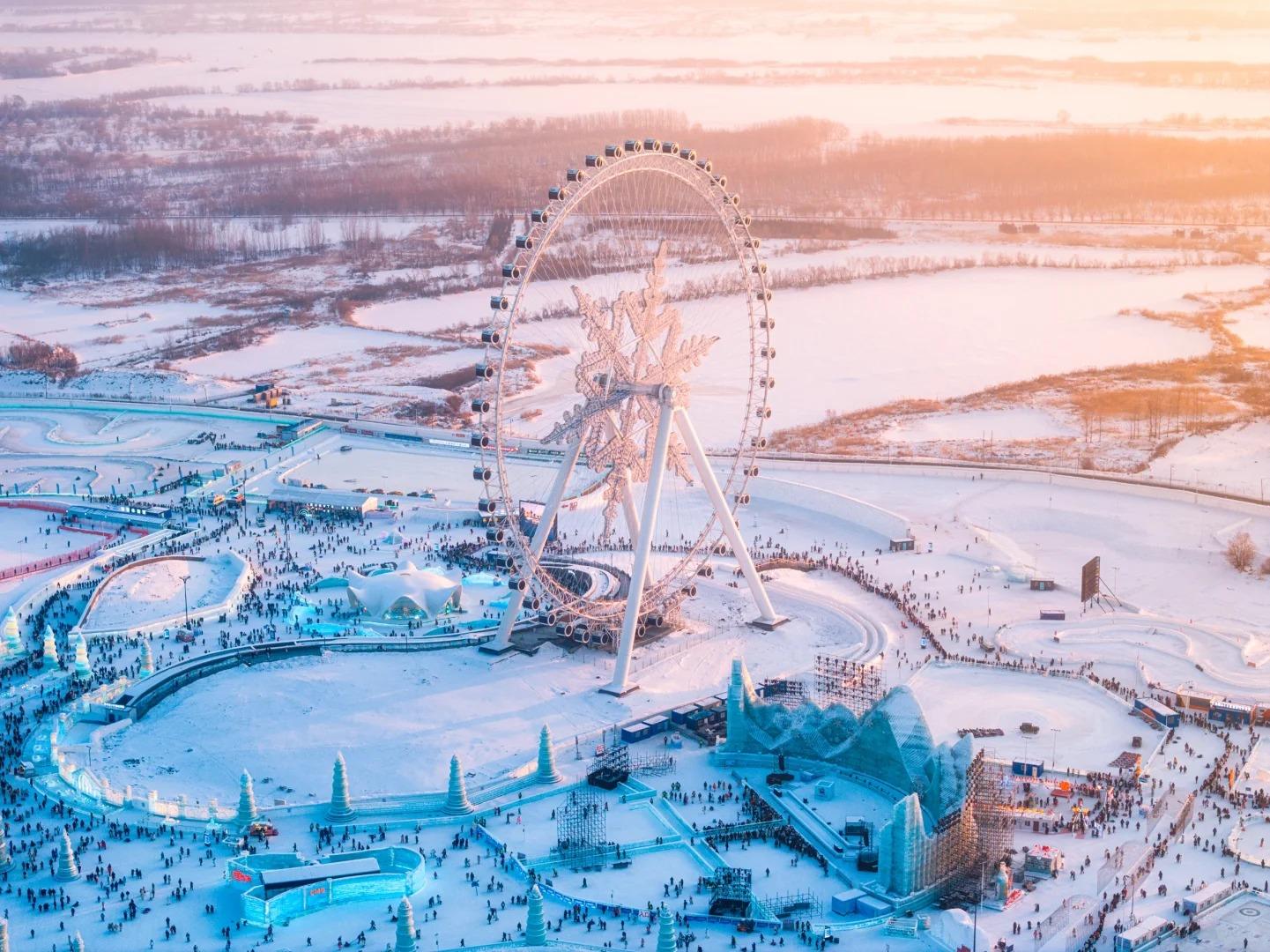Visiting Information
| Information | Details |
|---|---|
| Chinese Name | 哈尔滨国际冰雪节 (Hā’ěrbīn Guójì Bīngxuě Jié) |
| Location and Address | Harbin, Heilongjiang Province, China Main venue: Harbin Ice and Snow World, Sun Island |
| Opening Hours | Generally from late December to late February Ice and Snow World: 11:00 AM – 9:30 PM |
| Entrance Fee | Ice and Snow World: 330 CNY (peak season) Sun Island Snow Sculpture Art Expo: 240 CNY |
| How to Get There | By Bus: Take bus 29, 47, 80, 88, 119, 125, or 126 to Ice and Snow World By Taxi: Available from Harbin city center, about 30-40 minutes ride |
| Best Time for Visit | Late December to early February, with January being ideal |
| Contact Info | Phone: +86 451 8486 4269 Email: [email protected] |
Overview
The Harbin Ice Festival, officially known as the Harbin International Ice and Snow Sculpture Festival, is one of the world’s largest winter festivals. Held annually in Harbin, the capital of Heilongjiang Province in northeastern China, it showcases breathtaking ice and snow sculptures, massive illuminated ice buildings, and a variety of winter activities. The festival attracts millions of visitors from around the world, turning Harbin into a magical winter wonderland.
Historical Background
The Harbin Ice Festival has its roots in the local tradition of ice lantern making, which dates back to the Qing Dynasty. The festival officially began in 1963 as part of the city’s traditional ice lantern show and garden party. However, it was interrupted during the Cultural Revolution and was revived in 1985. Since then, it has grown from a local festival to an international event, becoming one of the world’s four largest ice and snow festivals alongside the Sapporo Snow Festival in Japan, Canada’s Quebec Winter Carnival, and Norway’s Ski Festival.

Architectural Features
- Ice and Snow World: The centerpiece of the festival, this massive park features full-sized buildings made entirely of ice blocks harvested from the nearby Songhua River. These structures, some reaching heights of 50 meters, are illuminated from within, creating a stunning, colorful display at night.
- Sun Island Snow Sculpture Art Expo: This area showcases enormous snow sculptures, some of which are over 100 meters long and 20 meters tall. The sculptures often depict scenes from Chinese history, mythology, or modern life.
- Zhaolin Park Ice Lantern Fair: This park hosts intricate ice sculptures and lanterns, continuing the traditional ice lantern art that inspired the festival. The sculptures here are often smaller and more detailed than those in the Ice and Snow World.
- Songhua River Ice and Snow Happy Valley: This area on the frozen Songhua River offers various winter activities and ice-based entertainment, including ice skating, ice sailing, and ice slides.
Cultural Importance
The Harbin Ice Festival is not just a tourist attraction; it’s a significant cultural event that celebrates the harsh winter of northeastern China. It showcases the resilience and creativity of the local people in transforming the challenges of extreme cold into a source of beauty and joy. The festival also plays a crucial role in preserving and promoting traditional ice and snow arts, particularly the art of ice lantern making. Moreover, it has become a platform for international cultural exchange, with ice sculptors from around the world participating and competing in various events during the festival.
Surrounding Attractions
- Saint Sophia Cathedral: A former Russian Orthodox church built in 1907, now a museum. Its distinctive green-domed Byzantine architecture stands out in Harbin’s winter landscape and offers a glimpse into the city’s multicultural history.
- Siberian Tiger Park: One of the world’s largest Siberian tiger breeding centers, located on the north bank of the Songhua River. Visitors can observe these magnificent creatures in a natural habitat-like environment.
- Central Street (Zhongyang Dajie): A pedestrian street featuring European-style architecture, reflecting Harbin’s unique blend of Chinese and Russian influences. It’s lined with shops, restaurants, and is particularly charming when covered in snow.
- Harbin Polarland: An indoor polar-themed park featuring various arctic and antarctic animals, including beluga whales, penguins, and polar bears. It offers a warm respite from the outdoor cold while still maintaining the winter theme.

Photography Opportunities
- Illuminated Ice Buildings: The massive, colorfully lit ice structures in the Ice and Snow World provide stunning photo opportunities, especially at night. The interplay of light and ice creates magical scenes that are a photographer’s dream.
- Snow Sculptures: The intricate and enormous snow sculptures at the Sun Island Snow Sculpture Art Expo offer excellent opportunities for both wide-angle landscape shots and close-up detail photographs.
- Ice Activities: Capture the joy and excitement of visitors engaging in various winter activities, from ice skating on the Songhua River to sliding down giant ice slides. These action shots can add a dynamic element to your photography collection.
- City Landscapes: Harbin’s European-style architecture covered in snow, particularly along Central Street and around Saint Sophia Cathedral, provides picturesque winter urban landscapes.
- Festival Events: The opening and closing ceremonies, as well as various performances and competitions during the festival, offer opportunities to capture the cultural aspects and human elements of the event.
Modern Importance
- Tourism Boost: The Harbin Ice Festival has become a major driver of winter tourism in China, attracting millions of domestic and international visitors each year. This influx of tourists significantly boosts the local economy during the winter months.
- Cultural Exchange: The festival serves as a platform for international cultural exchange, with artists and visitors from around the world participating. It helps promote understanding and appreciation of different cultures through the universal language of art.
- Technological Innovation: The creation of increasingly complex and large-scale ice and snow sculptures has driven innovation in ice construction techniques, lighting technology, and cold-weather event management.
- Environmental Awareness: As climate change becomes a growing concern, the festival has indirectly become a symbol of the importance of preserving winter environments. It raises awareness about the beauty and value of cold climates.
- Artistic Expression: The festival provides a unique canvas for artistic expression, pushing the boundaries of what’s possible with ice and snow as artistic media. It has fostered the development of ice and snow sculpture as a respected art form.

FAQ
- What is the Harbin Ice Festival famous for?
The Harbin Ice Festival is famous for its massive, illuminated ice sculptures and buildings, intricate snow carvings, and various winter activities. It’s known as one of the world’s largest winter festivals. - What’s inside the Harbin Ice Festival?
The festival features enormous ice buildings and sculptures in the Ice and Snow World, giant snow sculptures at Sun Island, ice lanterns at Zhaolin Park, and various winter activities like ice skating and sledding on the Songhua River. - Is the Harbin Ice Festival free?
No, the Harbin Ice Festival is not free. The main venues, such as the Ice and Snow World and Sun Island Snow Sculpture Art Expo, require paid admission. - Is the Harbin Ice Festival worth visiting?
Yes, many visitors find the Harbin Ice Festival worth visiting for its unique and spectacular ice and snow art, festive atmosphere, and the experience of a northern Chinese winter. - What to do in the Harbin Ice Festival?
Visitors can explore the ice buildings and sculptures, enjoy light shows, try winter activities like ice skating and sledding, watch cultural performances, and taste local winter delicacies. - How do I get to the Harbin Ice Festival in the local city?
In Harbin, you can reach the main festival venues by public bus (routes 29, 47, 80, 88, 119, 125, or 126 go to Ice and Snow World) or by taxi from the city center, which takes about 30-40 minutes. - How to visit the Harbin Ice Festival?
Plan your visit between late December and early February. Dress very warmly in layers. Purchase tickets for the main venues like Ice and Snow World and Sun Island. Visit the ice sculptures at night for the best illumination effects, and explore snow sculptures during the day. Consider joining a tour for easier transportation and information about the exhibits.





